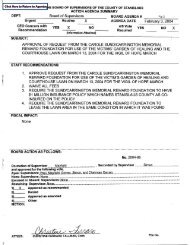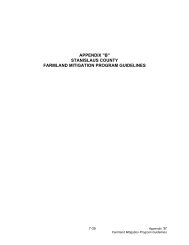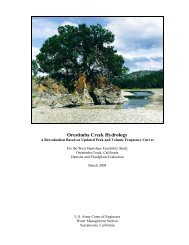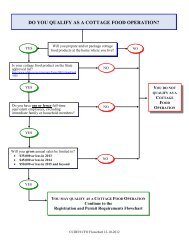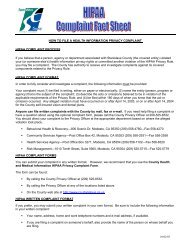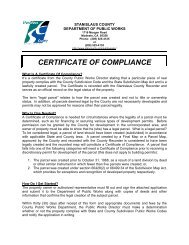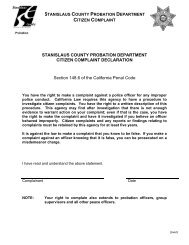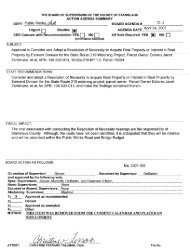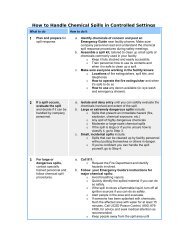Orestimba Creek Feasibility Study - Stanislaus County
Orestimba Creek Feasibility Study - Stanislaus County
Orestimba Creek Feasibility Study - Stanislaus County
Create successful ePaper yourself
Turn your PDF publications into a flip-book with our unique Google optimized e-Paper software.
Economics Appendix – Draft Report - <strong>Orestimba</strong> <strong>Creek</strong> <strong>Feasibility</strong> <strong>Study</strong>, <strong>Stanislaus</strong> <strong>County</strong>, California – September 2012<br />
5.0 Expected Annual Damages –Without Project Conditions<br />
5.1 HEC-FDA Model<br />
For the <strong>Orestimba</strong> <strong>Creek</strong> <strong>Feasibility</strong> <strong>Study</strong>, expected annual damages were estimated using the<br />
US Army Corps of Engineers, FRM-PCX certified risk-based Monte Carlo simulation program<br />
HEC-FDA v. 1.2.5a. Risk is a function of both probability and consequence, and the fact that<br />
risk inherently involves chance leads directly to a need to describe and plan for uncertainty.<br />
Corps policy has long been to acknowledge risk and uncertainty in anticipating floods and their<br />
impacts and to plan accordingly 4 . Historically, that planning relied on analysis of the expected<br />
long-term performance of flood-damage reduction measures, application of safety factors and<br />
freeboard, designing for worse case scenarios, and other indirect solutions (such as engineering<br />
judgment) to compensate for uncertainty. These indirect approaches were necessary because of<br />
the lack of technical knowledge of the complex interaction of uncertainties in estimating<br />
hydrologic, hydraulic, geotechnical, and economic factors due to the complexities of the<br />
mathematics required for doing otherwise. However, with advances in statistical hydrology and<br />
the availability of computerized analysis tools (such as HEC-FDA described below), it is now<br />
possible to improve the evaluation of uncertainties in the hydrologic, hydraulic, geotechnical,<br />
and economic functions. Through this risk analysis, and with careful communication of the<br />
results, the public can be better informed about what to expect from flood-damage reduction<br />
projects and thus can make more informed decisions. The determination of EAD for a flood<br />
reduction study must take into account complex and uncertain hydrologic, hydraulic,<br />
geotechnical, and economic information:<br />
<br />
<br />
<br />
<br />
Hydrologic - The discharge-frequency function describes the probability of floods equal<br />
to or greater than some discharge Q,<br />
Hydraulics - The stage-discharge function describes how high (stage) the flow of water<br />
in a river channel might be for a given volume of flow discharge,<br />
Geotechnical - The geotechnical levee failure function describes the levee failure<br />
probabilities vs. stages in channel with resultant stages in the floodplain, and<br />
Economics - The stage-damage function describes the amount of damage that might<br />
occur given certain floodplain stages.<br />
5.2 Estimation of Expected Annual Damages<br />
Figure 5-1 illustrates the conceptual risk approach for Corps’ flood damage analyses. To find the<br />
damage for any given flood frequency, the discharge for that frequency is first located in the<br />
discharge-frequency panel (panel #1), then the river channel stage associated with that discharge<br />
value is determined in the stage-discharge panel (panel #2). For the <strong>Orestimba</strong> <strong>Creek</strong> study it<br />
4 In a flood risk management study, risk is defined is the probability of failure during a flood event. Uncertainty is<br />
the measure of the imprecision of knowledge of variables in a project plan.<br />
21




